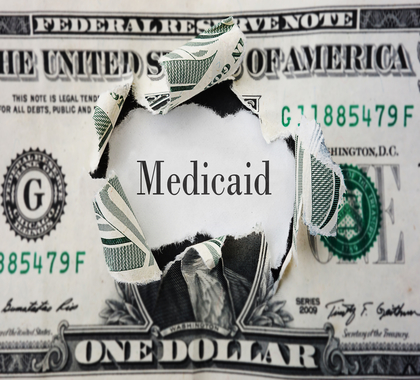With Medicaid spending and enrollment having increased in 2020 and projected to soar in 2021, federal law prevents states from disenrolling ineligible individuals, who account for an increasing share of spending.
Nationwide, Medicaid added four million people between March and June of this year, raising enrollment to 74.6 million, data from the Centers for Medicare and Medicaid Services (CMS) show.
Enrollment in Medicaid and the related Children’s Health Insurance Program for 2021 is projected to increase by 9 million individuals and spending by $86 billion from pre-COVID pandemic levels, states a joint report from the Congressional Budget Office and Joint Tax Committee released September 29.
A joint report from the Congressional Budget Office (CBO) and Joint Tax Committee released on September 29 says enrollment in Medicaid and the related Children’s Health Insurance Program is projected to increase by nine million people in 2021 and will cost taxpayers an additional $86 billion above pre-COVID pandemic levels.
Strings on Federal Funds
Oklahoma is one of the states that had a substantial increase in Medicaid enrollment, says Kaitlyn Finley, a policy research fellow at the Oklahoma Council of Public Affairs.
“From February to June this year, Oklahoma saw more than a 10 percent increase in Medicaid enrollment, from 785,366 to 865,851, the second-highest jump of all states,” Finley said.
Provisions of the Families First Coronavirus Response Act (FFCRA), signed into law by President Donald Trump on March 18, prevent the states from disenrolling anyone while the COVID emergency exists. That renders state eligibility audits unenforceable, says Finley.
“Currently, audits for the Oklahoma Medicaid program would have little impact, because the Oklahoma Health Care Authority cannot remove ineligible individuals due to the fact Oklahoma took federal funds from the FFCRA for its Medicaid program,” said Finley. “This provision will be in effect for the foreseeable future until the coronavirus public health emergency is not renewed.”
The COVID relief bill temporarily raised the federal share of Medicaid funding, the Federal Medical Assistance Percentage (FMAP) rate, but the costs to the state are likely to rise anyway, says Finley.
“Under the FFCRA, Oklahoma receives a temporary 6.2 percentage bump to their FMAP rate that is tied to the length of the public health emergency,” said Finley. “According to the Foundation for Government Accountability, the FMAP bump in FFCRA is expected to provide states with an additional $9 billion to $10 billion per quarter. This bump will draw down more funding for Oklahoma but is also likely to increase state spending as well, as total enrollment rises.”
Calls for Eligibility Checks
The states could be stuck with higher Medicaid bills when the enhanced federal match ends, says Chris Jacobs, founder, and CEO of Juniper Research Group.
“States should prepare for the process of reinstating their eligibility checks at the earliest possible opportunity once the COVID public health emergency lapses, which will hopefully occur in 2021,” said Jacobs. “Returning to these eligibility checks will help bolster the integrity of a program that CMS’ own data show is plagued with waste, fraud, and abuse.”
Improper payments to state Medicaid programs for enrollees whose eligibility was not verified by the states consumed more than 21 percent of the total federal match in the fiscal year (FY) that ended on September 30, CMS announced on November 16, 2020.
CMS estimated the loss to federal taxpayers rose from $57.31 billion in FY 2019 to $86.49 billion in FY 2020, based on data collected before the COVID-19 pandemic. CMS states it suspended data collection efforts “between March and August.”
Budgetary Symbolism
In 2019, CMS proposed a complex rule aimed at improving federal financial oversight of state Medicaid programs, which opponents said would reduce federal spending on the program by up to $50 billion a year. CMS Administrator Seema Verma withdrew the rule on September 14, 2020.
Verma wrote on Twitter the rule appeared to have “unintended consequences,” which require “further study.”
“The fiscal accountability rule would not directly address the matter of ineligible individuals, but it would bring some much-needed transparency and accountability to the gimmicks that state Medicaid programs use to bilk additional matching dollars out of Washington,” said Jacobs. “CMS should finalize the rule, to show its good stewardship of Americans’ hard-earned tax dollars.”
Jacobs says the action would be symbolic, however.
“As a practical matter, even if the Trump administration finalized the rule today [in December], it wouldn’t take effect until after January 20, and the Biden administration would almost certainly withdraw the rule before it went into effect,” said Jacobs.
Joe Barnett (joepaulbarnett@att.net) writes from Texas.





















